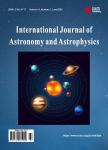The Evolution QSOs—The Optical Luminosity Function
The Evolution QSOs—The Optical Luminosity Function作者机构:Department of Physics Manipur University Canchipur India Department of Physics Pettigrew College Ukhrul India
出 版 物:《International Journal of Astronomy and Astrophysics》 (天文学与天体物理学国际期刊(英文))
年 卷 期:2013年第3卷第2期
页 面:87-92页
摘 要:Using the data of the 2 Degree Field (2dF) QSO Redshift Survey (2QZ) and the associated 6 Degree Field (6dF) QSO Redshift Survey (6QZ) of the Anglo-Australian Telescope, a study of the Optical Luminosity Function of Quasi Stellar Objects (QSOs) has been made to understand the evolutionary scenario of QSOs. Different models for the QSO evolution are studied. The two-power law model of the optical luminosity function with second order polynomial evolution is found to fit best the observed QSO optical luminosity function. We have also determined an improved evolutionary model which fits better than the second order polynomial evolution model. The best fit parameters for the observed optical luminosity function have been determined using the Levenberg-Marquardt algorithm of non-linear least square fit for a flat universe i.e., ΩΛ + Ωm = 1 and Ho = 70 km·s–1·Mpc–1. The observed slope of the log N - m curve i.e., 1.10 ± 0.01 reveals that there were more QSOs at larger distances (or look back times) than there are locally which, in turn, indicates that the QSOs are evolving. The observed value of V/Vmax is found to be greater than 0.5 for different values of the cosmological constant which also hints strong evolution of the QSOs.



